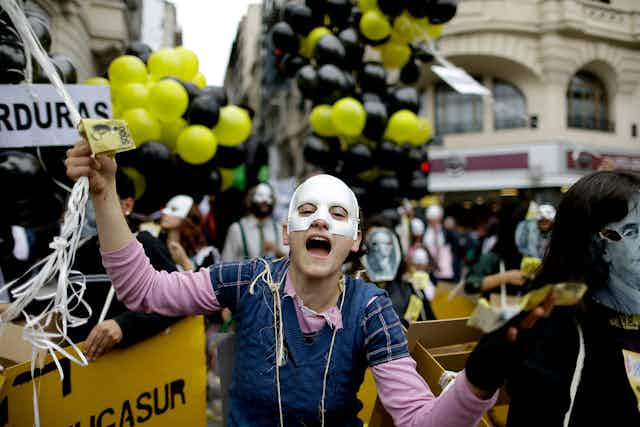An economy in recession. Pesos fleeing the country. The worst drought in decades. The world’s highest interest rates. The biggest bailout in the history of the International Monetary Fund.
Sound scary?
For Argentina, it’s more of the same, as it has suffered through many economic crises in recent decades. And pretty much every time, the catastrophic meltdowns ended with some combination of unsustainable national debt, high unemployment, rising poverty rates, looting, bank runs, capital flight and hyperinflation.
We’ve been following the ebbs and flows of the Argentine economy for two decades and are currently wrapping up a book on economic and fiscal policy in Argentina, Brazil and Chile. We’ve been wondering, could Argentina’s latest crisis turn out differently than the others?

It didn’t have to be this way
It’s not terribly hard for us to pinpoint what went wrong, since we predicted it last summer.
But it didn’t have to happen this way. Only two years ago, Argentina’s leadership had appeared to learn lessons from the past and were governing the economy pretty effectively.
After the country’s last crisis ended in default and massive poverty in 2002, the government was operating under strict financial constraints. Argentina’s leaders had to find ways to support its currency, increase tax revenue, lower poverty and increase employment. And they largely succeeded, which led to a stronger financial sector and peso, Argentina’s currency, for three main reasons.
First, while past governments responded to crises by adopting austerity policies, in 2003 the newly elected President Nestor Kirchner instead increased government spending using pesos (instead of borrowed dollars) to assist the poor, which in turn helped spur consumer spending. This led to less poverty, unemployment and income inequality.
Second, capital controls were implemented to keep pesos in Argentina. This ensured there wouldn’t be another run on the currency.
Finally, and most importantly, the government began using direct deposits to pay salaries and provide benefits, which significantly increased the percentage of the population in the formal banking system. Before then, more than half of citizens didn’t have a bank account or credit card, making it harder for the government to know their true earnings and tax them.
Thanks to the changes, the share in the banking system jumped to 90 percent, leading to record value-added tax collections, the Argentine government’s most important revenue stream. As a result, the country’s tax-to-GDP ratio – which is a measure of how well the government is collecting revenue – soared from an average of around 19 percent in the 1980s and 1990s to 32 percent in 2015, the highest in the region – something unthinkable only a decade prior.

Stoking a crisis
So when Mauricio Macri became president at the end of 2015, there was a foundation of beneficial policies in place that supported the government’s coffers.
He also had some challenges to contend with. Government spending was rising too quickly, while inflation was hitting 30 percent a year. But instead of tightening the reins on spending and pursuing a path of fiscal responsibility, the center-right Macri decided to cut taxes for businesses and borrowed record amounts in dollars to do so – all without reducing government spending. At the same time, he eliminated the capital controls put in place in 2002.
Unsurprisingly, all of this made the country more vulnerable to a crisis, which began in May when a particularly bad drought – the most expensive in Argentina’s history – dried up important export crops, such as soybeans and corn. Argentina is the world’s third-largest exporter of both.
Foreign investors, concerned about the government’s ability to meet its obligations, began dumping short-term central bank debt. Meanwhile Argentines, well-versed in any whiff of economic trouble, began to get rid of their pesos too.
By June, Argentina was seeking help from the International Monetary Fund in the form of a US$50 billion line of credit, which is the most a country has ever received from the institution.
But the injection of credit, as well as the central bank’s decision to hike interest rates to a world-high 60 percent, did little to stem the peso’s slump. The peso is down almost 50 percent in value since April versus the dollar.
Where will it lead
Fast forward to today.
The crisis has eased a bit as the peso stabilizes at just under 40 pesos per dollar – near its worst ever – which cost $15 billion of the IMF’s money to achieve. And the central bank is selling lots of bonds with interest rates over 60 percent to hold it there.
In other words, three months of 60 percent interest rates and billions of IMF cash have proved it’s expensive to wrestle the peso into submission. Even worse, all that borrowed money will need to be paid back, which puts further stress on the economy.
Meanwhile the IMF, which agreed to send over an additional $7 billion, is forecasting a deeper-than-expected recession.
While this does in fact look rather scary, fortunately, there’s room for optimism. And to answer our earlier question, yes, we do believe Argentina is not doomed to follow past crisis missteps and can return to a sustainable path of growth.
It’ll depend, however, on whether Argentina follows through on the IMF’s condition to eliminate the budget deficit by 2019. And whether it adopts other prudent policies such as increasing public revenue by re-instituting export taxes and putting in place currency controls to ensure a stable peso.
This is the approach Macri should have taken in December 2015. Still, it’s better late than never.


